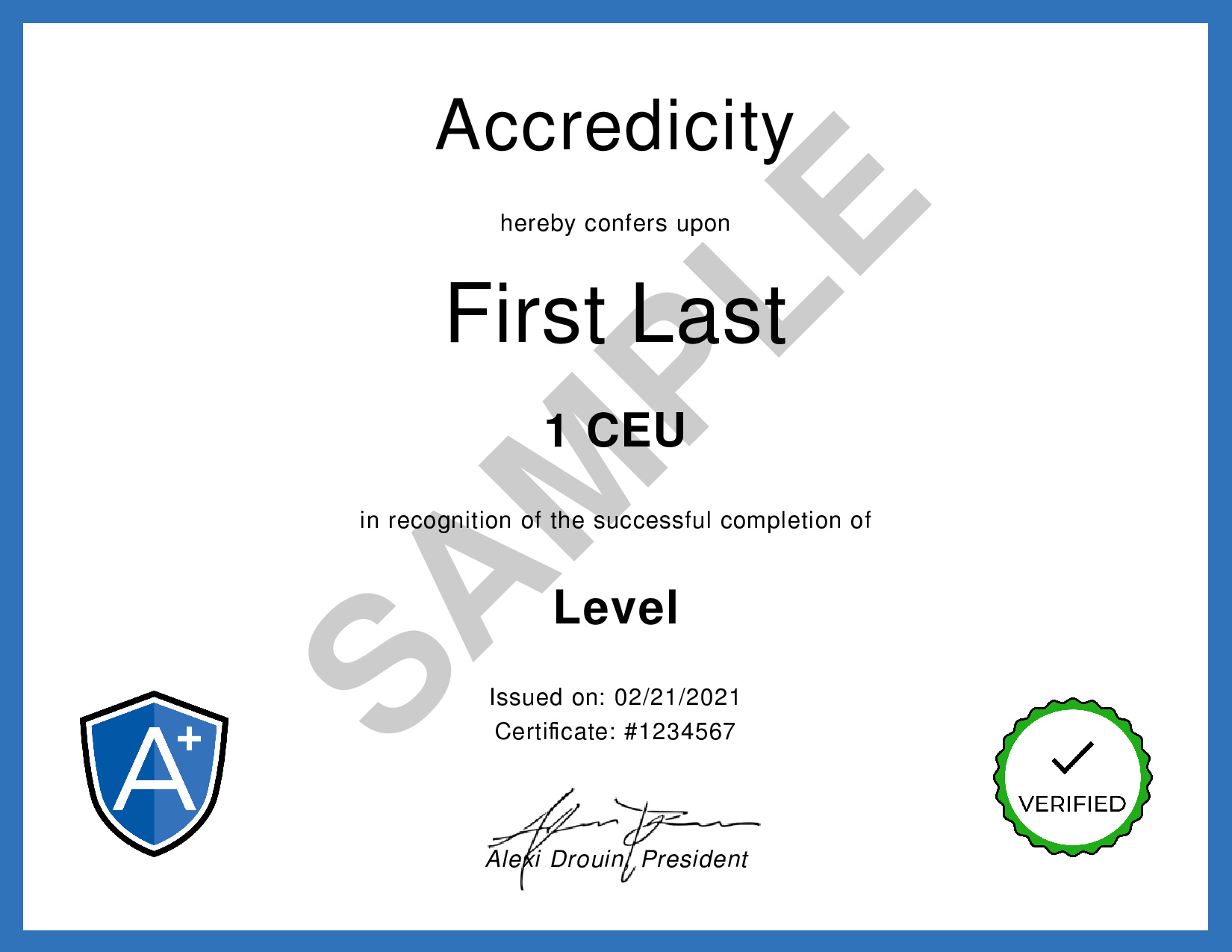SS13: How to Handle Conflict | CrashCourse
Reference: CrashCourse. (2019, June 05). How to Handle Conflict: Crash Course Business - Soft Skills 13 [Video]. YouTube.
We Make Your Education Count

Get the Credit You Deserve and Become the Most Attractive Job Candidate by Earning and Posting A+ Badges to Your Linkedin Profile.
Sign Up to Get Started at Accredicity
|
Learn how to handle conflicts like a pro with Crash Course Business: Soft Skills! This Crash Course Business video by Evelyn from the Internets explains how to handle conflict in the workplace. From distributive negotiation to collaboration, five general strategies are discussed, each with its own level of assertiveness and cooperativeness. It also outlines the importance of listening to understand other perspectives, and when to bring in a third party to intervene. Tips on giving effective feedback, apologizing, and avoiding harassment are also provided. Learning Outline1. Conflicts can arise from different working styles, communication styles, and preferences. Instructional ContentHandling conflict in the workplace can be a daunting task, but it is a skill that must be mastered in order to create and maintain a successful business. Conflict resolution takes finesse and thought, and it is important to understand the various strategies available for managing conflict. This Crash Course Business: Soft Skills video “How to Handle Conflict” covers five strategies for managing workplace conflict. These strategies range from compromise and collaboration to accommodation and avoidance. Each strategy has a different level of assertiveness and cooperativeness, and the right approach will vary depending on the situation. Compromise is an easy default and can be used when the conflict is as simple as dividing something up, like a distributive negotiation or splitting a check. Collaboration is a more creative solution that requires a baseline level of trust and is more effective when sorting out complex issues between departments. Authoritative command is the most assertive approach and can be useful when time is of the essence, like when a product needs to be printed before deadline. Accommodation can help smooth out tricky situations, but too much can give you a reputation as a doormat. Avoidance is also an option if the conflict is not your problem. Finally, enlisting the help of a third party, such as HR or a mediator, can provide a helpful, neutral perspective and provide assistance in dealing with more serious issues, such as harassment. By understanding and mastering these strategies, you can successfully handle any conflict that arises in the workplace. Management
|

Conflict happens all the time, especially at work. It's a normal part of life and it's important to know how to handle it. Everyone has different ideas, opinions, and ways they like to do things. Handling conflict can be tricky and it's important to be assertive but also cooperative when finding a solution. There are five strategies to try like compromising, collaborating, or avoiding. If it's a big conflict, it's a good idea to ask for help from someone like a manager or HR rep. You can also give effective feedback like using the 'Oreo method' of sandwiching negative comments between two positive ones. Handling conflict takes practice and skill but it's important to stay calm and treat others with respect. Video Quotes"The only person we ever fully understand is ourself. We’re all influenced by social perception. People see things differently, and we make assumptions based on our own experiences." -Evelyn from the Internets "It always takes time and effort to find creative solutions. But sometimes, things need to be done, like, now. If you’re dealing with getting a product printed before deadline, it may be worth giving an authoritative command, or using your authority to force someone into giving you what you need." -Evelyn from the Internets "When you’re sharing negative feedback, recognize that not everyone gives and receives it in the same way. Just look at Gordon Ramsay compared to the judges on Great British Bake Off. Feedback styles even vary by culture." -Evelyn from the Internets Related Quotes"Conflict can actually be a really positive thing, when managed properly." - John Green "You're going to have to be willing to confront it and address it, not just ignore it and hope it will go away." - John Green "Find a solution that works for everyone involved." - John Green Competencies1. Conflict Resolution Learning Outcomes1. Analyze the 5 general strategies for managing conflict (distributive negotiation, collaborative negotiation, authoritative command, accommodation, avoidance). Sample Answers1. From the video, I've learned that there are five main strategies to approach conflict: compromising, collaborating, accommodating, avoiding, and authoritative command. Each has a different level of assertiveness and cooperativeness which should be used depending on the situation. 2. Another important lesson I learned is to provide specific examples and explain the impact of the problem when giving negative feedback. This will help the other person understand the issue and provide them with a clear goal to work towards. 3. Additionally, I learned that it is important to consider the cultural context when dealing with conflict. Different cultures have different ways of giving and receiving feedback, and these should be respected. Evelyn from the InternetsEvelyn from the Internets is a conflict resolution and communication expert with over 15 years of experience. She is an Associate Licensed Marriage and Family Therapist and holds a Master's degree in Conflict Resolution and Mediation. She is a Certified Mediator and a Certified Life Coach. She is an expert in the field of resolving conflicts, both in personal and professional environments. Evelyn from the Internets has conducted workshops on conflict resolution and mediation techniques, as well as providing individual and group consultations. She is a member of the American Association for Marriage and Family Therapists and the International Association of Conflict Management. Evelyn from the Internets Learning DesignThese competencies are important for managers because they are critical to successful leadership and team dynamics. Conflict resolution, collaboration and coordination, and providing constructive feedback are all essential skills for managers. Conflict resolution is necessary for managers to create a safe and productive work environment. Managers must be able to identify, address, and resolve disputes between team members in order to keep the team focused on the task at hand. Collaboration and coordination allow managers to effectively manage the workflow and tasks of their team. Managers must be able to effectively communicate with their team and create a plan that ensures each team member is working together in order to achieve the desired results. Giving constructive feedback is also important for managers to provide feedback to employees and guide their development. Constructive feedback ensures that employees are continually developing their skills and improving their performance. To help build these competencies, students can use a framework such as the "4C's of Management": collaboration, communication, coordination, and constructive feedback. This framework provides students with a clear structure for learning and practicing these competencies. Additionally, students can use a pedagogy such as experiential learning, which allows them to gain hands-on experience working with the competencies. This will help them to develop a better understanding of how to effectively use each competency. AssessmentQ: According to the video, what is the Oreo method of giving negative feedback? Questions1. What are the five general strategies to approach conflict? Keywordsconflict management strategies, difficult conversations, distributive negotiation, collaboration, authoritative command, accommodate, avoidance, harassment, third-party intervention, negative feedback Oreo method Facts1. Conflict resolution strategies range from compromise to collaboration to accommodate. Trends1. Develop a conflict resolution template: Create a template that outlines the steps to take when approaching a conflict, such as listening to the other person, communicating, compromising, and giving effective feedback. 2. Create a conflict resolution checklist: Develop a checklist of key steps to take when resolving a conflict that employees can reference when needed. 3. Create a conflict resolution video: Produce a video that outlines the different strategies to managing conflict and how best to handle difficult conversations. 4. Develop a conflict resolution workshop: Create a workshop that employees can attend to learn the different strategies for resolving conflicts. 5. Create a conflict resolution toolkit: Create a toolkit for employees to refer to when dealing with conflicts. The toolkit could include strategies, tips, and resources on how to handle difficult conversations and resolve conflicts. SourceThis learning instructional guidance was formulated using the GPT-3 language model created by OpenAI. ShareConflict is unavoidable in the workplace, but it can be managed with finesse. Try out different strategies to find the best fit for the situation: compromise, collaborate, accommodate, or avoid. Need help? Go to a third party or HR rep. #CommunicationSkills #ConflictResolution #SoftSkills @Accredicity |








 58 Creds - Management
58 Creds - Management



